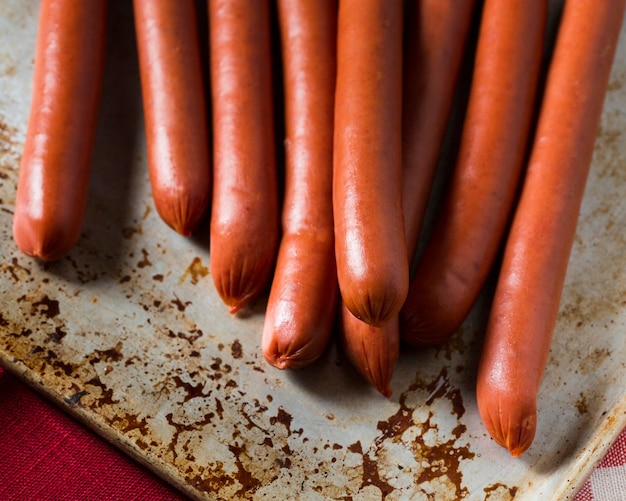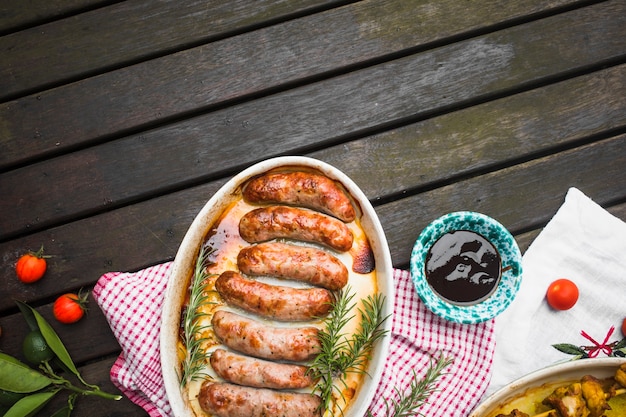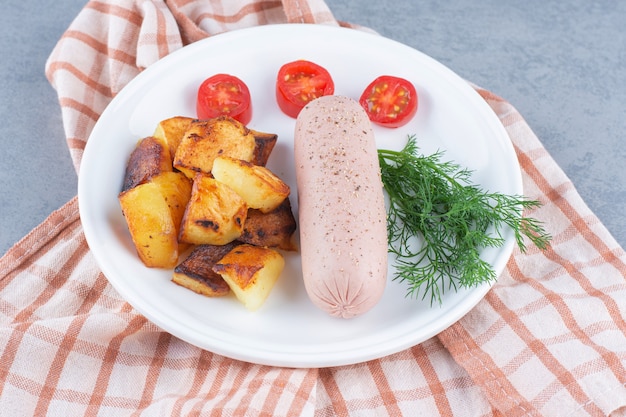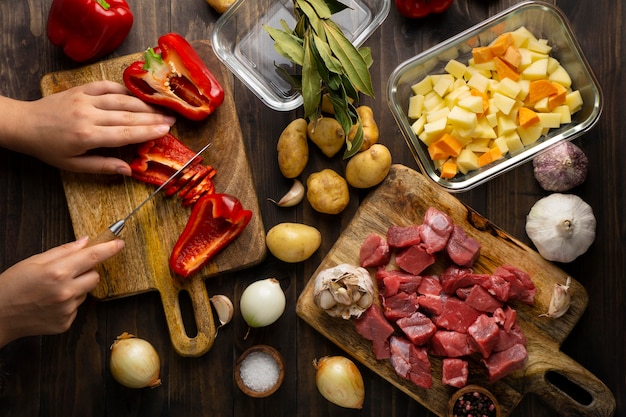(Part 1) Understanding Chicken Sausage

The Anatomy of a Sausage
Before we dive into the cooking process, let's understand what makes up these delightful little tubes of meat. Chicken sausages, as you might expect, are made primarily from chicken meat, minced and mixed with a blend of seasonings and fillers. The mince is often a combination of chicken breast and thigh, offering a perfect balance of moisture and flavor. You'll find that the chicken breast provides a leaner, more delicate texture, while the thigh adds juiciness and richness. The seasonings can vary wildly, from simple salt and pepper to more adventurous blends incorporating herbs, spices, and even vegetables. I've encountered some truly intriguing variations like garlic and herb, spicy chorizo, and even sweet apple and sage. Then there are the fillers. These can include breadcrumbs, flour, and even milk or cream, which bind the sausage mixture and contribute to its moisture content. Some sausages might also contain other ingredients like onions, garlic, or even cheese.Choosing Quality Sausages
I've learned the hard way that the quality of your chicken sausage truly matters. Seek out sausages from a reputable butcher or supermarket, and pay attention to the meat-to-filler ratio. Look for sausages that are predominantly meat, with minimal fillers. If you're buying pre-packed sausages, check the label carefully for ingredients. Avoid sausages that contain an abundance of additives or preservatives. I always try to steer clear of sausages loaded with sugar and salt. Consider looking for organic options, as they often use higher quality ingredients.(Part 2) cooking chicken Sausage: The Basics

Grilling: Embracing the Smoky Char
grilling chicken sausages is a classic method for a reason. The smoky char and those crispy edges are truly unbeatable. However, grilling requires attention to detail to ensure even cooking and prevent sticking. Here's how I approach it:- Preheat your grill to medium heat. I always preheat for about 10 minutes to make sure it's good and hot. This ensures even cooking and prevents the sausages from sticking.
- Lightly oil the grill grates. A thin layer of olive oil or vegetable oil will prevent sticking and help create those beautiful grill marks.
- Place the sausages on the grill, leaving a bit of space between them for air circulation. Crowding the grill can lead to uneven cooking and steaming instead of browning.
- Cook for about 8-10 minutes, turning every couple of minutes. This ensures even browning and helps prevent the sausages from sticking.
- The sausages are done when they are cooked through and have a nice golden brown color. They should feel firm to the touch, not soft or squishy.
Pan-Frying: A Quick and Easy Weeknight Option
Pan-frying is my go-to method for quick weeknight meals. It's simple, requires minimal effort, and you have complete control over the cooking temperature.- Heat a drizzle of oil in a large pan over medium heat. I prefer olive oil for its flavor and health benefits, but you can use any oil you like.
- Add the sausages to the pan, leaving some space between them. Again, avoid overcrowding to ensure even cooking.
- Cook for 8-10 minutes, turning them regularly. This will ensure they brown evenly and cook through. They should feel firm to the touch when they are done.
Oven-Baking: The Hands-Off Approach
If you prefer a more hands-off method, oven-baking is the way to go. This is especially convenient when cooking multiple sausages, as the oven will cook them evenly without requiring constant attention.- Preheat your oven to 350°F (175°C). This ensures the sausages cook evenly and reach the proper internal temperature.
- Place the sausages on a baking sheet lined with parchment paper. This prevents sticking and makes clean up a breeze. You can also use a baking dish. Make sure there's a bit of space between the sausages for even cooking.
- Bake for 20-25 minutes, turning them halfway through. This helps ensure that they cook evenly on all sides.
(Part 3) Cooking Times and Temperatures

Now, let's talk about those all-important cooking times and temperatures. These can vary depending on the size and thickness of the sausages and the method you choose. But don't worry, I've got a handy table to guide you.
Chicken Sausage Cooking Times
| Cooking Method | Time | Internal Temperature |
|---|---|---|
| Grilling | 8-10 minutes | 165°F (74°C) |
| Pan-Frying | 8-10 minutes | 165°F (74°C) |
| Oven-Baking | 20-25 minutes | 165°F (74°C) |
Remember, these are just general guidelines. It's always a good idea to check that the sausages are cooked through. The most reliable way is to use a meat thermometer. Insert it into the thickest part of the sausage, and it should reach 165°F (74°C).
If you don't have a meat thermometer, you can check for doneness by making a small slit with a knife. The meat should be white and no longer pink.
(Part 4) Tips and Tricks
Now that we've covered the basics, let's dive into some tips and tricks to help you cook perfect chicken sausages every time. I've gathered these from years of sausage-making and experimentation, so you can trust these tips!Don't Overcook
Overcooking is one of the biggest mistakes people make with sausages. It leads to dry, crumbly sausages that lack flavor. It's better to err on the side of slightly undercooked than overcooked. You can always cook them a little longer if needed.Don't Crowd the Pan
Crowding the pan will lead to steam building up, making the sausages steam instead of brown nicely. This will result in soggy, less-than-delicious sausages. Give your sausages some space to breathe and cook evenly.Don't Pierce the Sausages
Avoid piercing the sausages with a fork or knife while they are cooking. This allows the juices to escape, leading to dry sausages. Let them cook undisturbed, turning them gently every few minutes.Add a Splash of Water
If the sausages start to stick to the pan while frying, add a splash of water. This creates steam and helps loosen them up. Be careful not to add too much water, as it could make the sausages soggy.Use a Meat Thermometer
I always recommend using a meat thermometer to check the internal temperature of your sausages. It's the most reliable way to ensure they are cooked through. A decent meat thermometer is a worthwhile investment for any cook.(Part 5) Delicious Chicken sausage recipes
Now that you're a sausage-cooking expert, let's explore some delicious ways to use them! Chicken sausages are incredibly versatile, working their way into all sorts of dishes. Here are a few of my favorites:Chicken Sausage and Bean Casserole: A Hearty and Comforting Dish
This casserole is a perfect choice for a chilly evening. Simply brown some sausages in a pan, then add onions, garlic, peppers, and beans. Season with herbs and spices to your liking, then simmer until everything is heated through and the beans are tender. This dish is even better the next day!Chicken Sausage and Potato Skewers: A Quick and Easy Summer Meal
For a quick and easy summer meal, try these delicious skewers. Thread some sausages and potato chunks onto skewers, brush with olive oil, and season with your favorite herbs and spices. Grill or bake until the sausages are cooked through and the potatoes are tender. They are perfect served with a salad or some grilled vegetables.Chicken Sausage and Apple Salad: A Fresh and Flavorful Option
For a lighter option, try this salad. Fry some sausages until cooked through, then slice them into bite-sized pieces. Toss with a mix of salad greens, chopped apple, walnuts, and a light vinaigrette dressing. This salad is fresh and flavorful, perfect for a warm summer day.Chicken Sausage Pasta: A Crowd-Pleasing Favorite
This quick and easy pasta dish is always a crowd-pleaser. Cook some pasta, then toss it with some cooked sausages, chopped tomatoes, onions, and garlic. Season with herbs and spices to your liking, and you're good to go! You can also add a dollop of cream or sour cream for extra richness.Chicken Sausage and Mushroom Soup: A Warm and Comforting Treat
For a warm and comforting soup, try this recipe. Sauté some sausages and mushrooms in a pan, then add chopped onions, garlic, and vegetable stock. Simmer until everything is cooked through, then blend until smooth. This soup is delicious served with a dollop of cream or sour cream and some crusty bread.(Part 6) Storage and Leftovers
Now, let's talk about storage and leftovers. It's important to store your chicken sausages properly to ensure they stay fresh and safe to eat.Storing Uncooked Chicken Sausage
Uncooked chicken sausages should be stored in the refrigerator at 40°F (4°C) or below. Ideally, use them within 1-2 days of purchase. If you need to store them for longer, you can freeze them. To freeze, wrap them tightly in plastic wrap or aluminium foil, then place them in a freezer-safe bag.Storing Cooked Chicken Sausage
Cooked chicken sausages should be stored in the refrigerator at 40°F (4°C) or below. They'll keep for 3-4 days in the fridge. To reheat, you can microwave them, fry them in a pan, or bake them in the oven.Freezing Cooked Chicken Sausage
You can also freeze cooked chicken sausages for later use. Simply let them cool completely, then wrap them tightly in plastic wrap or aluminium foil. Place them in a freezer-safe bag and freeze for up to 2-3 months. To reheat frozen sausages, thaw them in the refrigerator overnight, then reheat them as you would fresh sausages.(Part 7) Chicken Sausage Substitutions
Sometimes you might not have chicken sausages on hand, or you might be looking for a different flavor profile. Don't worry, there are plenty of delicious substitutions you can use. Here are a few ideas:pork sausage: The Classic Alternative
Pork sausage is a classic alternative to chicken sausage. It has a richer flavor and higher fat content, which makes it juicier. You can use pork sausage in any of the recipes above, but be aware that it may need to cook for a little longer than chicken sausage.italian sausage: Bold and Spicy
Italian sausage is another great option. It's typically made with pork and seasoned with fennel, garlic, and red pepper. It has a bold and spicy flavor that's perfect for pasta dishes and pizza toppings. You can also use Italian sausage in any of the recipes above, but be aware that it may need to cook for a little longer than chicken sausage.Turkey Sausage: A Lower-Fat Option
For a lower-fat option, you can use turkey sausage. It has a milder flavor than pork sausage and cooks quickly. You can use turkey sausage in any of the recipes above.Vegetarian Sausage: A Plant-Based Delight
If you're looking for a vegetarian option, there are plenty of delicious vegetarian sausages available. They are typically made with a combination of vegetables, grains, and legumes. You can use vegetarian sausages in any of the recipes above, but be aware that they may need to cook for a little longer than chicken sausage.(Part 8) FAQs
Q1: Can I use a meat thermometer to check if my sausages are cooked through?
Absolutely! A meat thermometer is the best way to ensure your sausages are cooked through. Insert the thermometer into the thickest part of the sausage, and it should reach 165°F (74°C). If you don't have a thermometer, you can check for doneness by making a small slit with a knife. The meat should be white and no longer pink.
Q2: How can I make sure my sausages don’t stick to the pan?
The key to preventing sticking is to make sure your pan is properly heated before adding the sausages. And don’t overcrowd the pan! Give the sausages some space to cook evenly. You can also lightly oil the pan with olive oil or vegetable oil to prevent sticking. If they start to stick, add a splash of water to create steam and help loosen them up.
Q3: Can I cook chicken sausage from frozen?
You can certainly cook chicken sausage from frozen, but it will take longer. Add 5-10 minutes to the cooking time for frozen sausages. Be sure to check the internal temperature to ensure they are cooked through.
Q4: What are some of the best ways to reheat cooked chicken sausage?
There are a few ways to reheat cooked chicken sausages. You can microwave them, fry them in a pan, or bake them in the oven. Microwave for 30-60 seconds, or until heated through. Fry in a pan over medium heat for 2-3 minutes, turning occasionally. Bake in a preheated oven at 350°F (175°C) for 10-15 minutes, or until heated through.
Q5: What are some creative ways to use leftover chicken sausages?
Leftover chicken sausages are perfect for adding flavor to other dishes. You can chop them up and add them to soups, stews, or salads. You can also use them to make a sausage and lentil curry or a sausage and potato pie. Get creative and experiment!
That's it for this sausage odyssey! I hope you've picked up some useful tips and tricks to help you cook the perfect chicken sausage every time. Now, get out there and get cooking! I'll be back soon with another culinary adventure.
Everyone is watching

Perfect Rice Every Time: The Ultimate Guide to Cooking Rice
Cooking TipsAs a self-proclaimed foodie, I've always been a bit obsessed with rice. It's the foundation of countless cuisi...

Ultimate Guide to Cooking the Perfect Thanksgiving Turkey
Cooking TipsThanksgiving. Just the word conjures up images of overflowing tables laden with delicious food, the scent of r...

The Ultimate Guide to Cooking Asparagus: Tips, Techniques, and Recipes
Cooking TipsAsparagus. The mere mention of this spring delicacy conjures up images of vibrant green spears, crisp and burs...

Can You Cook Spaghetti with Gasoline? (The Shocking Truth)
Cooking TipsWe've all seen those crazy internet trends. You know, the ones that make you wonder, "Did someone actually try...

Chorizo and Eggs Recipe: The Ultimate Guide
Cooking TipsRight, let’s talk about chorizo and eggs. You know, that classic Spanish dish that's always a winner. It's th...
